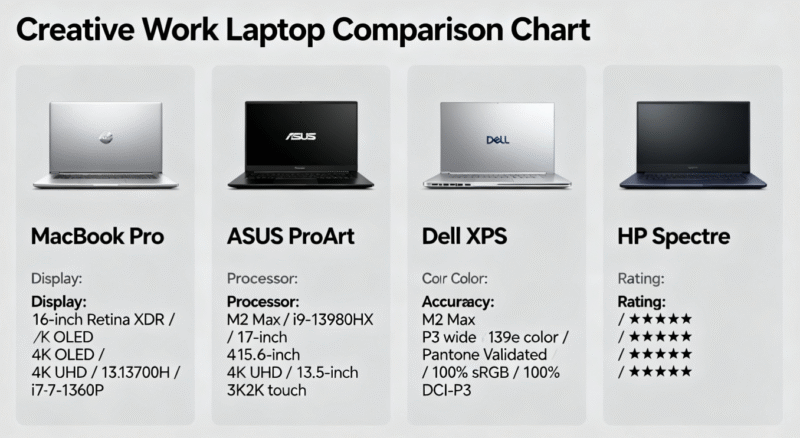Last updated on November 18th, 2025 at 12:53 pm
Okay, I will tell you, I nearly purchased a wrong laptop on three occasions. I would pour over spec papers, wondering whether 16GB of RAM was sufficient or I needed 32GB, and, in fact, whether the graphics was built in or was the sort of graphics that creates a PowerPoint presentation back in 2005.
This is what I observed after trying out a number of laptops and interviewing real-life designers who use them on their daily lives.
Table of Contents
Mac vs Windows Thing (Let’s Settle This).
So I tested both. The Apple MacBook Pro 14 features M4 Pro and the ASUS ProArt P16. Here’s my take.
The MacBook just works. I opened it, opened Photoshop and the colors at once were correct. No calibration, no driver updates, no bizarre crashes. The M4 chip supports 4K video without it being as a space heater. And the battery will last through a whole working day -10+ hours of real design work.
The catch? It’s expensive. And in case you are accustomed to windows operating software, or in case you require a particular program that does not work with their macOS, then you are in a jam.
Now, the ASUS ProArt P16. It is a beautiful 4K OLED display, and supports a drawing pen, which is ideal when it comes to the idea of digital drawing. Performance benchmark demonstrates that it is able to rival the MacBook Pro in regards to rendering work. However,–and here is a point–you will be wasting time adjusting settings and updating drivers. More babysitting is required in windows laptops.
The following is my recommendation: buy the Mac in case you are using Final Cut Pro or you are already in the Apple family. Should you require flexibility, certain windows software or desire additional bang to your buck, then choose windows.

Decoding the Specs
This is where I got stuck. What does “NPU” even mean? What is the reason why a laptop has 16GB RAM and another 32GB? Let me break it down.
RAM (Memory): This reflect on this as your workplace. I discovered that 16GB is sufficient enough to perform basic video and photo editing. However, 32GB helped to smooth out 4K footage editing with effects in DaVinci Resolve when I attempted to edit it. When doing 3D work or a lot of video editing, it is not a place to save money.
GPU (Graphics Card): Built-in graphics are good enough in case of graphic design and photo editing. Seriously. But video editing and 3D work? You need a dedicated GPU. I used an RTX 4060 which reduced my rendering time by a half when compared to integrated graphics.
Display: This is what counts more than you think. My colors were totally different when I sent files to clients with a laptop having a simple 1920×1080 screen. Get one that has 100 percent sRGB or more. OLED displays will provide you with more black, and a higher amount of contrast- worth having in case you do color-sensitive work.
NPU (Neural Processing Unit): New technology that processes AI on-board. Such features as background blur in real-time, image generation, and AI-based creative applications are quicker. Not necessary but coming to be usual in 2025.
What Matters in regards to various creative work.
I have discussed with one of my photographer contacts that he is an avowed 16GB RAM and a screen with accuracy of color. One of my acquaintances is a video editor who will not touch below 32GB with RTX GPU. Everything is operated on a MacBook Air by a graphic designer.
Reason is: Have the laptop to suit your work.
Photo Editing: 16GB RAM, high display (100 per cent sRGB), speedy SSD. GPU doesn’t matter much.
Video editing: 32GB RAM, dedicated graphical card (RTX 4060 or more), awesome cooling. Battery life will suffer.
3D Modeling: Minimum RAM required is 32GB, a powerful graphics card, fast processing unit. The posts at Reddit affirm that this is not something to bargain on.
Graphic Design: 16GB RAM, precise display, Portable. Majority of designers do not require mad-dog specifications.
The Budget Reality Check
Only thing nobody tells you is that you cannot get everything. The price of premium laptops begins at 1,00,000+. Mid-range options sit at 60,000-80,000. Budget selections begin at [?]40,000 although you will sacrifice on display quality or gpu power.
I would prefer to obtain more RAM and display than stylish chassis. There is always an option of any external storage, but you could not upgrade soldered RAM afterward (learned that the hard way).
My Final Take
My final purchase selection would be:
In the majority of the creative work: MacBook Air 15 M4. It is slim, powerful enough to design and make light video and the battery is everlasting.
Serious video/3D, need not be expensive: ASUS ProArt P16 or MacBook Pro 14 M4. Bases on your software ecosystem.
To the cost-efficient designers: Acer Swift Go 14. It is not glorious but does the job of graphic design.
The real trick? Be aware of what you are really doing most of the time. I believed that I would require the highest power, but, in fact, I use Photoshop and Illustrator 90 percent of my time. I could’ve saved money.
Don’t overthink it. Select according to your core operations, ensure that the display is correct and get ample RAM. All of the rest is mere details.
Also Read: Best Products to Buy 2025: Your Ultimate Tech Buyer’s Guide for Cutting-Edge Gear
Hi, I’m Veena and I’m passionate about sharing honest, in-depth reviews that help people make smarter choices. I’ve spent years exploring products, tech, and trends, and I enjoy breaking things down in a way that’s easy to understand. Whether it’s a gadget, app, or lifestyle tool, I aim to give you clear, practical insights based on real experience.
Connect with me on LinkedIn
